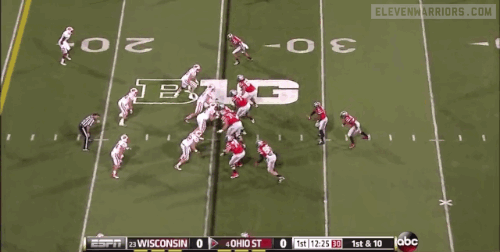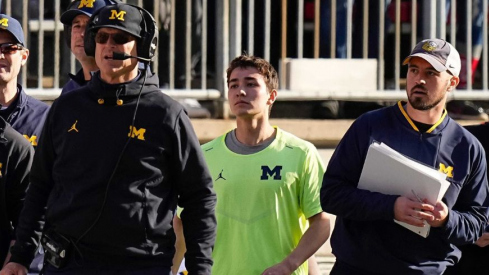
Halfway through the 2013 season, the Ohio State offense has exhibited a more diversified attack, averaging .63 points per play. But the Buckeyes have also bogged down for stretches at a time, keeping games closer than they otherwise would be.
Some of this stop and go quality is a result of Ohio State's two primary play makers – Braxton Miller and Carlos Hyde – missing significant time. This has hamstrung developing the cohesiveness of the offensive play calling and personnel use, as Urban Meyer and Tom Herman are still figuring out how to meld their offensive components.
Despite demonstrating such room for improvement, the Buckeyes' offense has been fairly prolific. Above all, Ohio State can always turn to Miller and Hyde behind a stellar offensive line to gain crucial yardage.
Below I examine the Buckeyes' game planning, ball distribution, the need to consistently rely upon play action passing, and where the Buckeye offense can improve.
(Multiple) Game Plans
In 2012, the Buckeyes' game plan was essentially run Hyde inside, Miller outside and on designed runs, rely on Corey Brown underneath with the occasional shot down field to Devin Smith.
But the Buckeye coaching staff has had to adjust their formula throughout the early season to the reality of multiple games without Hyde and Miller. Without Hyde, the Buckeyes placed less reliance on their tight (inside) zone play. Without Miller, Meyer and Herman emphasized backup quarterback Kenny Guiton's strengths. Guiton is excellent with read and option plays, but is not a true threat running the football. He throws well off play action, but lacks the arm strength to throw down field when he cannot put air under the football.
The Buckeyes accordingly featured what Guiton does best, using ample amounts of speed option,

as well as play-action and bootleg passing.
With Miller and Hyde's return, the Buckeyes have reverted towards its 2012 formula. Ohio State seeks to first and foremost rely upon Hyde running inside zone behind the Buckeye offensive line and Miller on lead quarterback runs and speed option This is particularly the case when Meyer and Herman feel the need to tighten up the offense.
The Buckeye offensive line has largely been as good as expected, particularly once center Corey Linsley fully returned from injury. Right tackle Taylor Decker has occasionally had difficulties with a speed pass rush, but the line has otherwise been stout, particularly in the run game. This is even more impressive against teams focused upon stopping the run. In crucial situations Buckeyes generally rely upon their left side of Jack Mewhort and Andrew Norwell, who continue to play at an all-conference level.
Expansion
That does not mean that the Buckeye offense is simply a mirror of 2012, however. The Buckeyes are more proficient throwing the football. This begins with Miller. Miller is certainly not a finished product, and his bouts of inconsistency has slowed the OSU offense. But Miller's improved footwork and arm angle has made him a more accurate passer and he has the arm strength to complete any throw. He is also improved as a scrambler. He has become more instinctual as to when to run, rather than sitting dead foot in the pocket.
The Ohio State passing game is led by Brown, who has firmly cemented himself as the third primary offensive option. As Meyer stated, the Buckeyes game plan to get Brown involved. Brown's primary role is still picking up critical middle of the field yards, but Meyer and Herman also look to get him the football on wide receiver screens.

At a schematic level, the above clip is but one example of the Buckeyes' increased reliance on packaged plays. Ohio State will package a short pass play as part of Miller's backside read, having him eye the defender responsible for the backside receiver. If the defender seeks to contain Miller on zone read he will pull the football and throw.


The Buckeyes' passing game has also been particularly effective in two other areas – play action and hitting explosive passes over the top. These two concepts are mutually beneficial, as the Buckeyes are able to complete throws behind run-focused linebackers and safeties. For instance, below, Wisconsin's safety quickly came up to contain Miller on zone read, giving the Buckeyes an easy two on one with a switch route.

Taking What they give you
This effectiveness of the Buckeyes' passing game in part reflects defenses continued focus upon Ohio State's run game. Defenses generally seek to put at least one additional defender in the box then Ohio State has blockers. They do so in one of two ways – bring a safety down or cheat a slot defender inside.

In heavy run situations defenses have gone further, seeking to get a plus-two advantage in the box by playing cover 0.

More specifically, opponents game plan to prevent Miller from getting outside contain. For instance, defenses are often using two backside defenders to account for Miller on zone read, using one defender to attack the mesh point and either a slot defender or safety to maintain force support.

This is and of itself is not a problem. Meyer and Herman's goal is to use the run game to force a defense to play an additional defender against the run to open up the passing game. This is a large part of why the Buckeyes increasingly rely upon packaged plays. It is difficult for Miller to keep and gain positive yardage outside a contain-focused defender. But Ohio State can pick up easy yards in the passing game if that defender is leaving a receiver uncovered to focus upon Miller.
The lengths teams are going to take away Miller as a runner also results in overly harsh criticism of Miller on read plays. Miller must undoubtedly improve upon reading defenders. As Meyer has stated, it is an area where Guiton is better. But there are several things to keep in mind. Certain runs that look like reads do not actually have a read component. This is particularly the case when the Buckeyes' tight end is on the line away from the run play, or slice blocks back across the play.

Second, Ohio State's default rule is, when in doubt, give the ball. As Herman states if the quarterback is going to be wrong in his read they want him to be wrong giving the football. As such there will undoubtedly be plays where any OSU quarterback will look as if they should have kept because they are following the default rule.
Within that framework, Miller has improved in the read game. For instance, against Northwestern, Miller recognized that Northwestern was scheming to defend him on inverted veer and correctly gave to Carlos Hyde.
Compare that to last year against Wisconsin, where Wisconsin used a similar strategy but Miller refused to give the football. Miller's improved recognition is also reflected in the staff's increased willingness to have Miller read packaged plays. As is often the case with Miller, the improvement comes in fits and starts, but is on an upward path.
Pulling it Together
That is not to say that Miller's play or Ohio State's play calling has gone off without a hitch. The Buckeyes have bogged down at times as they have become overly reliant upon designed runs for Miller and the drop back passing game. Miller has been more effective as a runner then some have given him credit for. He has been more willing to run north and south and taken what is available. But he largely has not created any explosive run plays, as much a reflection of the opponent's overt focus on Miller as it is on Miller's knee injury or supposed tentativeness.
More inexplicably, the Buckeyes get away from play action on first down to feature drop back concepts. The Buckeyes have been far more efficient throwing the football after threatening the defense with the run. By contrast, teams have shown a propensity to drop eight against the Buckeyes' drop back game, using their three man rush to fence Miller in the pocket and force him to pick through tight zones. Northwestern successfully employed such a strategy, thwarting the Buckeyes' attempt to hit vertical routes. The Buckeye passing game correspondingly became less efficient as they unsuccessfully tried to throw deep.
A defense cannot take such deep drops when the Buckeyes threaten the opponent with run action. If the goal is to force a defense into applying an additional defender against the run game, the best way to take advantage of this result is to use play action to draw up those defenders and throw behind. This is particularly the case when a safety's primary responsibility is containing Miller.
And practically speaking, the Buckeyes have been more efficient off play-action. Self-evidently, Ohio State cannot entirely rely upon play action looks. But it should be Ohio State's primary means of throwing the football on first and second down.
A comparison to Oregon is instructive. Like Ohio State, Oregon's primary play maker is its quarterback, Marcus Mariotta. Everything the Ducks do builds off their read run game. They primarily throw off play action, either hitting post and crossing routes behind run-support safeties or featuring Mariotta on bootleg flood plays. The Ducks then called designed runs for Mariotta to threaten the edge, particularly when they need crucial yards. The result is a cohesive offense that punishes a defense overplaying its hand.
And Moving Forward
Meyer and Herman are right to rely upon Miller and Hyde behind the Buckeye offensive line. But the Buckeye coaching staff must not become overly reliant when a defense is entirely focused upon those two. This requires two subtle adjustments. As noted, Ohio State must not get away from play action. Meyer and Herman apparently realized that in the second half against Northwestern, as Ohio State went back to what was successful early in the game. If a team seeks to employ Wisconsin's fourth quarter strategy and overload the box with cover 0, the Buckeyes can accomplish the same ball control goals by using Miller on bootlegs or packaged plays and giving him a run/pass option.
Second, the Buckeyes must work to include players such as Jordan Hall and Dontre Wilson. It helps that Hyde is showing the versatility to threaten a defense outside. The Buckeyes are also rightly reluctant to take Brown out of the H slot receiver position.
But Hall and Wilson can encourage a diversified ground approach, particularly when teams key on Hyde and Miller. Meyer stated this week that Wilson is too much a one-trick pony, only able to be utilized on outside runs or as a decoy. But the Buckeyes must utilize him as a threat and a decoy in limited circumstances, because it forces a defense to adjust.
In hindsight, Hall was likely hurt by Hyde's absence, as the coaching staff needed him at tailback and could not sufficiently plan how to use he and Hyde in tandem. But he is too much of a threat to not play in certain circumstances. Hall does not rise to the level of Hyde or Brown as a play maker, but he is experienced and versatile, particularly as a change-up to Hyde and as another option to threaten the defense's edge. If the coaches do not trust Wilson in certain situations then Hall needs to fill that role.
The upshot is that if defenses must contend with the Buckeye offensive line and Hyde off inside run and the resulting play action game, teams cannot overly focus upon containing Miller. With two games under Miller and Hyde's belt, the Buckeye coaching staff should have the opportunity to use the bye week to self-assess and work upon better meshing together the component pieces of the Ohio State offense.

